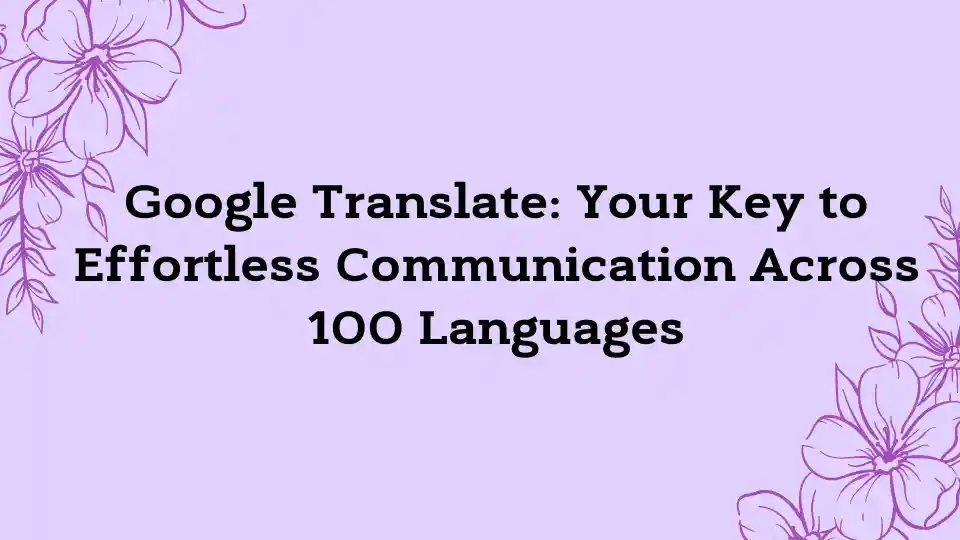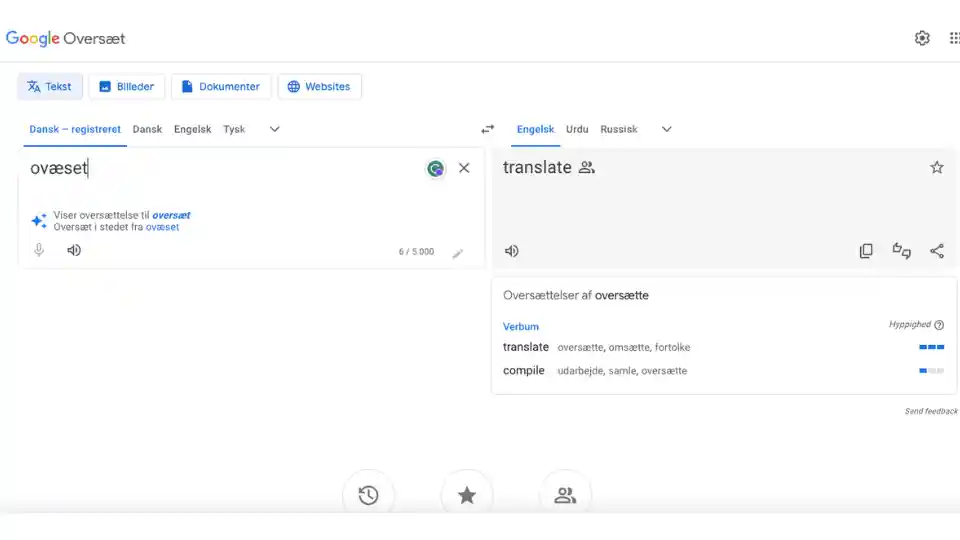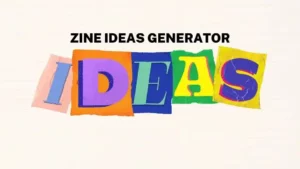
Google Translate
Need help reading a foreign language website or deciphering a message from someone who doesn’t speak English? What if you could instantly understand information in over 100 languages with a button? Well, now you can. Google Translate is your key to unlocking effortless communication across languages.
Whether you need to translate a single word, full sentences, or even entire web pages, Google Translate has you covered.
Their free service instantly translates between English and languages ranging from Spanish and French to Arabic and Vietnamese. Forget spending hours with language dictionaries and translators.
With Google Translate, the world is at your fingertips. Understanding people from all cultures and walks of life has always been challenging.
Using Google Translate, users can speak and understand different languages via a multilingual neural machine translation tool. You can use it on a website, on your phone if you have Android or iOS, or even with other software developers. It can translate text, documents, and websites from one language to another.
In 2022, it could work with 133 languages at different levels. 2016, more than 500 million people were using it, translating more than 100 billion words daily. But back in 2013, they were helping 200 million people daily.
When it started in 2006, it used official documents from the United Nations and European Parliament to learn languages. Instead of directly translating one language to another, it often went through English first. Then, it is translated to the target language. But there were some exceptions, like Catalan to Spanish.
When it translates, it looks at many documents to see how words are used. This helps it choose the right words and correctly combine them in the new language. But some have said it’s only sometimes accurate, especially for certain languages.
2016, Google made it even smarter with something called Google Neural Machine Translation. It can translate whole sentences simultaneously, making it more like how humans speak with proper grammar.
So go ahead, explore the web, and connect with more people than ever before. Your universal translator awaits.
How Google Translate Works: Instant Two-Way Translation
When you want to understand what someone is saying in another language, Google Translate is your instant two-way translator. It can translate text, speech, images, and real-world scenes between 108 languages in seconds.
Google Translate uses state-of-the-art neural machine translation, which transforms the sequence of words in one language into the most relevant sequence in another. It goes beyond just translating word for word by considering the context and meaning of the text. The more Google Translate is used, the smarter it gets, as it learns over time to produce more accurate and natural translations.
How to Get Started
It’s simple to get started with Google Translate. Go to translate.google.com, select the language you want to translate from and to, and type or paste in the text, upload an image, or speak into your microphone. The translation will instantly appear. You can also translate bilingual conversations in real-time with the conversation mode.
Enter the web page URL you want to translate into the search box. The translation will load in seconds. Google Translate works on desktop and mobile; many features are available in the Google app and Chrome browser.
Whether you need to understand correspondence from international colleagues, chat with friends or relatives in their native language, navigate a foreign website, or satisfy your curiosity about how a word or phrase translates, Google Translate removes the language barrier and makes communication effortless. Give it a try—you’ll be conversing across languages quickly!
Top Features of Google Translate You Should Know About
Google Translate is more than just a digital dictionary. This free service can instantly translate words, sentences, and even entire web pages between English and over 100 languages.
Some of the top features you’ll want to take advantage of include:
- Automatic language detection. Enter some text or a URL, and Google Translate will automatically detect the language. No guessing is required!
- Text translation. Enter words, phrases, or sentences in one language and get the translation in your selected target language. Google Translate supports natural translations that sound like real people, not robotic responses.
- Website translation. There is no need to copy and paste content from foreign web pages into the translator. Just enter the URL, and Google Translate will translate the entire page.
- Offline translations. Download language packs to get translations even when you’re not connected to the internet. Perfect for using Google Translate on the go.
- Image translation via camera. Point your camera at signs, menus, or other text, and see the translated text overlaid on your screen. It is an incredibly useful feature for navigating foreign countries.
- Pronunciations. Need help with saying a foreign word or phrase correctly? Tap the speaker icon next to any word or sentence to hear how native speakers pronounce it.
With all these useful features, you can break down language barriers and better understand other cultures through Google Translate. Give it a try – you’ll be conversing comfortably across languages quickly!
Accuracy of Google Translate Across Languages
Google Translate aims to provide accurate translations across many languages, but some perform better than others. As an AI system, it continues to improve over time based on data, but human review and correction are still needed to reach human-level quality.
Romance languages
Google Translate does a good job if you’re translating between English and Romance languages like Spanish, French, Italian, or Portuguese. These languages share Latin roots, so many cognates (words with the same origin) and grammatical similarities help the system translate accurately.
Germanic languages
Google Translate also performs well for Germanic languages like German, Dutch, Norwegian, and Swedish. Again, the linguistic similarities between these tongues help enable high-quality translations.
Asian languages
Translating between English and major Asian languages like Chinese, Japanese, Korean, and Hindi can be more difficult. These languages have different alphabets, tonal systems, and grammatical rules that challenge machine translation. Google Translate does okay for simple phrases and sentences, but longer, more complex translations can sound unnatural or inaccurate. If precise communication is important, consider finding a native speaker for review.
Rare or regional languages
Google Translate’s accuracy depends highly on the data available for smaller languages like Welsh, Basque, or regional dialects. The more people who use the system and provide feedback, the more it improves. But for niche languages, human translators still reign supreme.
While Google Translate provides a good starting point for casual communication across many tongues, for professional or high-stakes translation needs, human translators are recommended to ensure the highest quality results. But for quick conversational phrases to connect with others around the globe, Google Translate can open you up to a whole new world of shared understanding.
How to Use Google Translate on Desktop and Mobile
Google Translate makes it effortless to communicate across languages. The interface is clean and simple to use on both desktop and mobile.
On Desktop
On google.com/translate, select the language you want to translate from and to using the drop-down menus. Enter the text or web page URL in the left box, and the translation will instantly appear in the right box.
You can enable the “Tap to Translate” feature for even quicker translations, which lets you double-click words or highlight sentences on any webpage to see the translation. In addition to the Chrome Extension, which provides easy translation access, you can download the Google Translate App.
To hear the proper pronunciation of the translation, click the speaker icon. You can also save translations to use again later. Check the dictionary and thesaurus options for help with a specific word or phrase.
On Mobile
The Google Translate app, available for Android and iOS, provides the same simple interface and instant translations as the desktop version. Just speak or type the word, phrase, or sentence you want to translate, and your translation is displayed or spoken aloud.
Real-time translations of conversations with people who speak foreign languages are available in conversation mode. The app will detect which language is being spoken and translate it to another language. Over 100 languages are supported, so Google Translate is your key to unlocking communication worldwide.
Whether on desktop or mobile, Google Translate takes the guesswork out of communicating across languages. By instantly translating words, sentences, conversations, and web pages, Google Translate brings people together and helps you understand the world.
Common Mistranslations to Watch Out for When Using Google ovæset

Google Translate is a useful tool for quickly getting the gist of foreign language text. Still, it’s important to remember that machine translation is imperfect.
When we search Oversæt (overset), iversær, oversør, ovæset, google oversæt, oversaæt, foversæt, oversæt engelsk dansk, oversætte, oversæt engelsk, ovesæt, ovæset, oversættelse, överseta, oversæt hjemmeside, google oversættelse, ovestæ, Google Translate is the only result. Other words are for transalte in english like oversættelse til engelsk and oversættelse dansk engelsk.
Here are some common ways Google Translate can trip up beginners and lead to mistranslations:
Context Matters
Google Translate considers each sentence individually, without the surrounding context. This can lead to incorrect translations for sentences that depend heavily on context. For example, word-for-word, translating “I didn’t say she stole my money” could be incorrectly translated to mean the opposite in another language.
Figurative Language
Idioms, metaphors, similes, and other figurative language do not translate directly between languages. Phrases like “once in a blue moon” or “piece of cake” will not translate accurately.
Grammar Differences
Languages have different rules for grammar, syntax, and punctuation. Google Translate struggles with complex grammar and may translate long, compound sentences incorrectly or rearrange the structure strangely.
Regional Dialects
A single language like Spanish or Arabic encompasses many regional variations and dialects. Google Translate is trained on formal, standardized versions of languages, so translations may sound unnatural or contain unfamiliar words for certain regions or contexts.
Proper Nouns
Proper nouns like personal names, place names, brand names, and acronyms are often transliterated rather than translated. This can lead to incorrect pronunciations or spellings of names when translated. Double-check any proper nouns in the original text.
While Google Translate can be a quick reference tool, finding a fluent human translator for important documents is best. They can properly account for context, idioms, grammar, and regional variations to accurately translate your foreign language text.
Languages supported
Google Translate supports the following 133 languages as of August 2023:
| Afrikaans | Albanian | Amharic | Arabic |
| Armenian | Assamese | Aymara | Azerbaijani |
| Bambara | Basque | Belarusian | Bengali |
| Bhojpuri | Bosnian | Bulgarian | Catalan |
| Cebuano | Chichewa | Chinese (Simplified) | Chinese (Traditional) |
| Corsican | Croatian | Czech | Danish |
| Dhivehi | Dogri | Dutch | English |
| Esperanto | Estonian | Ewe | Filipino |
| Finnish | French | Frisian | Galician |
| Georgian | German | Greek | Guarani |
| Gujarati | Haitian Creole | Hausa | Hawaiian |
| Hebrew | Hindi | Hmong | Hungarian |
| Icelandic | Igbo | Ilocano | Indonesian |
| Irish | Italian | Japanese | Javanese |
| Kannada | Kazakh | Khmer | Kinyarwanda |
| Konkani | Korean | Krio | Kurdish (Kurmanji) |
| Kurdish (Sorani) | Kyrgyz | Lao | Latin |
| Latvian | Lingala | Lithuanian | Luganda |
| Luxembourgish | Macedonian | Maithili | Malagasy |
| Malay | Malayalam | Maltese | Maori |
| Marathi | Meiteilon (Manipuri) | Mizo | Mongolian |
| Myanmar (Burmese) | Nepali | Norwegian | Odia (Oriya) |
| Oromo | Pashto | Persian | Polish |
| Portuguese | Punjabi | Quechua | Romanian |
| Russian | Samoan | Sanskrit | Scots Gaelic |
| Sepedi | Serbian | Sesotho | Shona |
| Sindhi | Sinhala | Slovak | Slovenian |
| Somali | Spanish | Sundanese | Swahili |
| Swedish | Tajik | Tamil | Tatar |
| Telugu | Thai | Tigrinya | Tsonga |
| Turkish | Turkmen | Twi | Ukrainian |
| Urdu | Uyghur | Uzbek | Vietnamese |
| Welsh | Xhosa | Yiddish | Yoruba |
| Zulu |
Conclusion
So there you have it: With Google Translate at your fingertips, you have a key to unlock worldwide communication. Whether you need to quickly decipher a foreign menu or have a full conversation, this free tool covers you.
Next time some unfamiliar text stumps you, or you want to connect across languages, open Translate and let it work its magic. Before you know it, barriers will disappear, and understanding will emerge.
So start translating and open up a whole new world of communication – endless possibilities!
To read more about technology, visit zine ideas.








